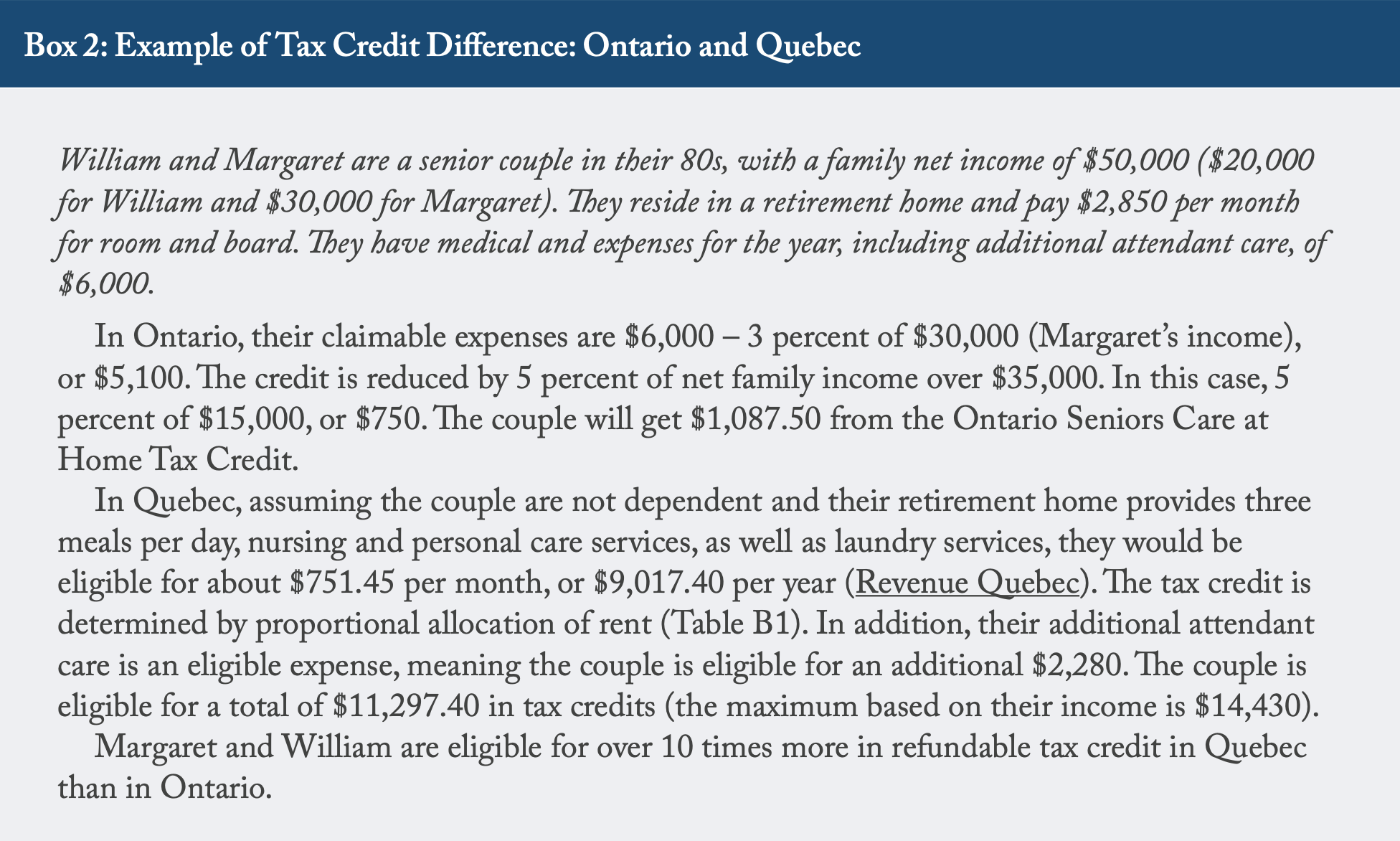
A summary of Scenarios for Seniors’ Care: Future Challenges, Current Gaps and Strategies to Address Them - C.D. Howe Commentary no. 656
Elderado
May 9, 2024, Updated on May 9, 2024
In April 2024 the C.D. Howe Institute published a 32-page Commentary - Scenarios for Seniors’ Care: Future Challenges, Current Gaps and Strategies to Address Them. You can find the full commentary HERE. In this blog we will summarize some of the key points.
Just the highlights
- $1 of every $4 of provincial healthcare spending goes to caring for people over 75 years-old
- A 13% reduction in ALC (Alternate Level of Care) days would be sufficient to prevent hospital bed shortages
- About 30% of new residents moving into long-term care could be delayed or prevented from having to move with expanded home & community care
- About half of seniors currently living in retirement homes have needs that would qualify them for public home & community care
- It costs tax payers less if seniors receive advanced care services at home, or in retirement homes, than in long-term care or hospitals
- Ontario should look to Quebec, where there are more senior care spaces, lower vacancy, lower rent, and they provide more support to senior households through tax credits
Scenarios for Seniors' Care
Canada’s healthcare system is poised to face significant challenges due to the country’s rapidly aging population. The Commentary by the C.D. Howe Institute, Scenarios for Seniors’ Care: Future Challenges, Current Gaps and Strategies to Address Them by Rosalie Wyonch examines these challenges, explores existing gaps, and proposes strategies to meet the needs of the growing senior population.
Key issues include a surge in demand for seniors’ care due to the aging baby boomer population, coupled with constrained fiscal resources and insufficient capacity in retirement and long-term care (LTC) homes.
Challenges with Alternate Level of Care (ALC) Patients
ALC patients are individuals occupying hospital beds even though their care needs could be met in alternative settings, such as LTC homes or through home care. ALC patients represent a significant challenge to Canada’s healthcare system, occupying between 12.7% and 27.5% of acute-care beds across provinces and accounting for 15.5% of all acute-care bed-days.
High Costs and Inefficiencies
- The cost of caring for ALC patients in hospitals ranges from $730 to $1,200 per day.
- In comparison, LTC costs taxpayers about $225 to $253 per day.
- Hospitals are ill-suited to handle the long-term care needs of seniors and provide suboptimal environments, often contributing to health declines.
Systemic Barriers to Discharge
- A lack of available LTC beds and inadequate home and community care services prolongs hospital stays for ALC patients.
- Physician incentives and risk aversion can favor longer hospital stays, as clinicians prefer to avoid complications related to insufficient post-discharge care.
Opportunities to Improve ALC Patient Care
Invest in Home and Community Care
- Expanding home care services and increasing subsidies can prevent unnecessary hospital admissions and expedite discharges.
- Support services can help seniors stay in their homes longer.
Increase LTC and Retirement Home Capacity
- Building more LTC spaces and expanding public and private retirement homes can relieve pressure on hospitals.
- Enhanced tax credits or subsidies can improve access.
Enhance Informal Caregiver Support
- Financial assistance and respite services can reduce caregiver burnout and prevent unnecessary hospitalizations.
- Tax credits and training programs for caregivers can help.
%20(1200%20x%20800%20px).png)
Home and Community Care: Gaps and Recommendations
Canada's investment in home and community care is lower than that of other OECD countries, contributing to gaps in service and unmet needs.
(OCED is Organisation for Economic Co-operation and Development, and includes the United Kingdom, Germany, France, Belgium, Netherlands, Sweden, Australia, South Korea, USA, and more)
Unmet Needs
- About 6.1% of Canadian households receive formal home care services, while 2.8% have unmet home care needs.
- Unmet needs are highest in British Columbia and Ontario (3.1%).
Funding Sources and Costs
- Government sources cover 52.2% of home care services, while 27% are paid out-of-pocket.
- Nursing care services are more likely to be government-funded than personal support services.
Regional Variations in Care
Ontario
- Public home care services are delivered based on assessments by health professionals.
- Third-party agencies handle service delivery.
Quebec
- Seniors can access discounted home help through the Financial Assistance Program for Domestic Help Services.
- Rent in retirement homes can be partially eligible for tax credits.
British Columbia
- Home care services are subsidized based on eligibility and income level.
- Personal care and household tasks are included in home support services.
Alberta
- Home care is narrowly focused on medical support, offering limited assistance for household tasks.
Strategic Recommendations for Home and Community Care
Invest in Public and Private Services
- Increase investment in public home care services while enabling private sector expansion.
- Vouchers, tax credits, and subsidies can help make private services accessible.
Reduce Informal Caregiver Burden
- Provide respite services and financial assistance to informal caregivers.
- Foster innovative technology to support seniors and caregivers.
Tailor Solutions by Region
- Replicate successful provincial models, such as Quebec's tax credits, to improve accessibility in other provinces.

Tax Credits for Seniors’ Care
The report emphasizes that tax credits can help make senior care more accessible and affordable. However, Ontario lags behind Quebec in providing comprehensive tax credits.
Quebec's Model
Home Support Services Tax Credit
- People over 70 can claim up to 38% of eligible expenses (up to $7,020).
- Eligible expenses include personal care, housekeeping, meal preparation, and nursing.
- Rent in retirement homes is partially eligible if it includes supportive services.
Independent Living Tax Credit
- Seniors can claim 20% of expenses for home modifications to improve accessibility.
Respite Services Credit
- Caregivers can claim 30% of expenses for respite services.
Ontario's Model
Ontario Seniors Care at Home Tax Credit
- Seniors over 70 can claim 25% of eligible expenses up to $1,500.
-
- Eligible expenses include personal support, assistive devices, and medical equipment.
Federal Home Accessibility Tax Credit
- Seniors can claim up to $10,000 for accessibility modifications.
Recommendations for Ontario's Tax Credits
1. Adopt Quebec’s Refundable Tax Credit Model
- Include rent deduction in retirement homes for services like housekeeping and personal care.
- Raise the reimbursement rate to provide comprehensive support.
2. Expand Eligible Services
- Include more services like personal care, nursing, meal preparation, and housekeeping.
3. Increase Overall Support
- Raise the value of tax credits to reflect Quebec's support levels.

Key Statistics on Senior Households and Spending Patterns
Understanding the economic challenges faced by seniors is crucial to shaping effective policies.
Household Composition and Spending
- 13.5% of Canadian households include a senior over the age of 75.
- 42% of senior households consist of a single person, and 35% are couples.
- Average household spending is $14,440 on housing and $3,260 on healthcare.
Affordability Challenges
- Below-median income senior households spend 46% of their expenditures on shelter and food.
Housing Adequacy and Core Need
- Senior households have higher rates of inadequate, unsuitable, or unaffordable housing.
- In Ontario, 52.3% of senior renters face housing challenges, and 23.9% live in core need housing.
Conclusion
The report Scenarios for Seniors’ Care: Future Challenges, Current Gaps and Strategies to Address Them provides a comprehensive overview of the challenges and opportunities in senior care. Addressing these challenges will require strategic investments in home and community care, expanding long-term care and retirement home capacity, and leveraging tax credits to make senior care more accessible. By taking a proactive approach, Canada can better meet the needs of its growing senior population while ensuring fiscal sustainability and a high quality of life for all seniors.
Elderado
May 9, 2024